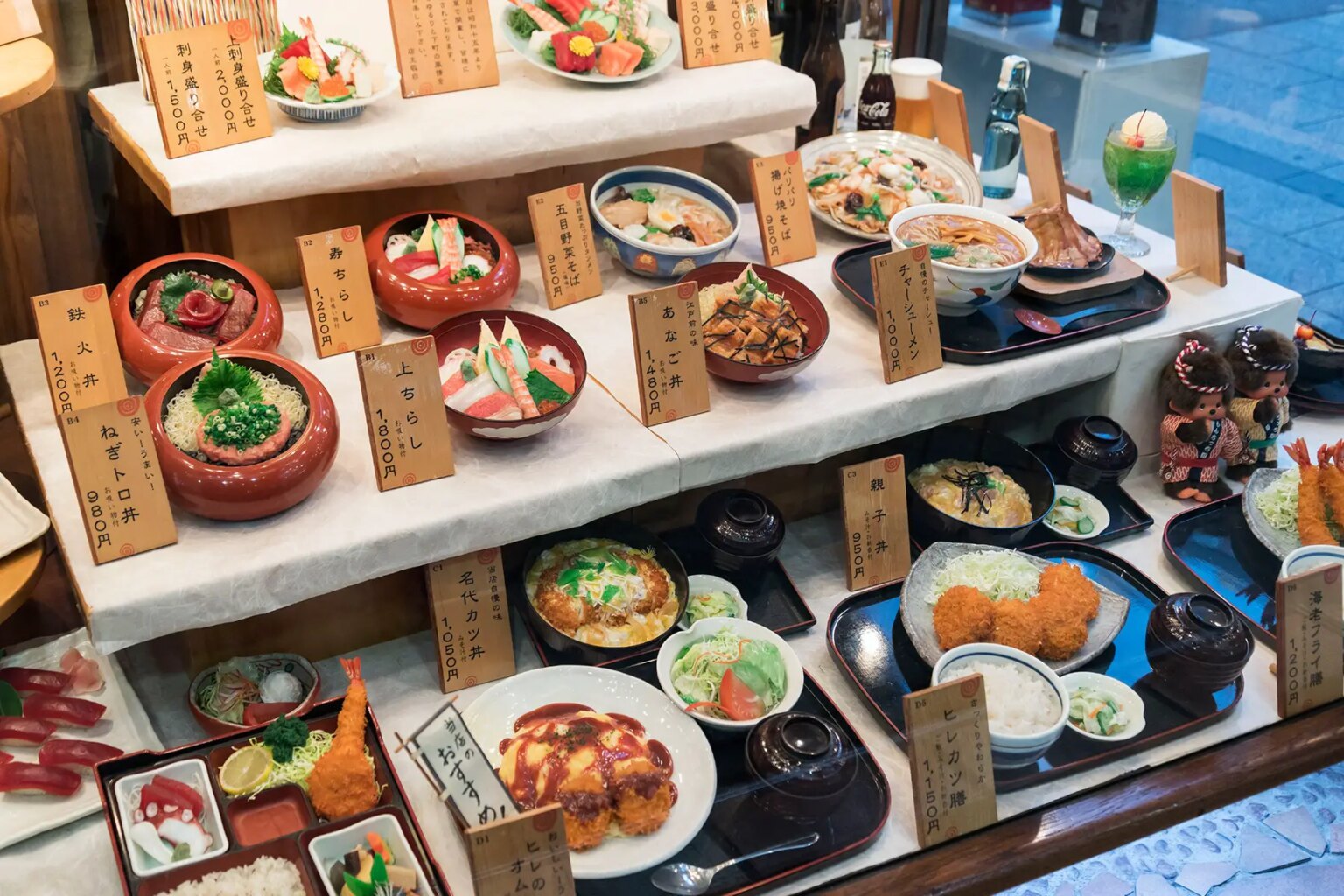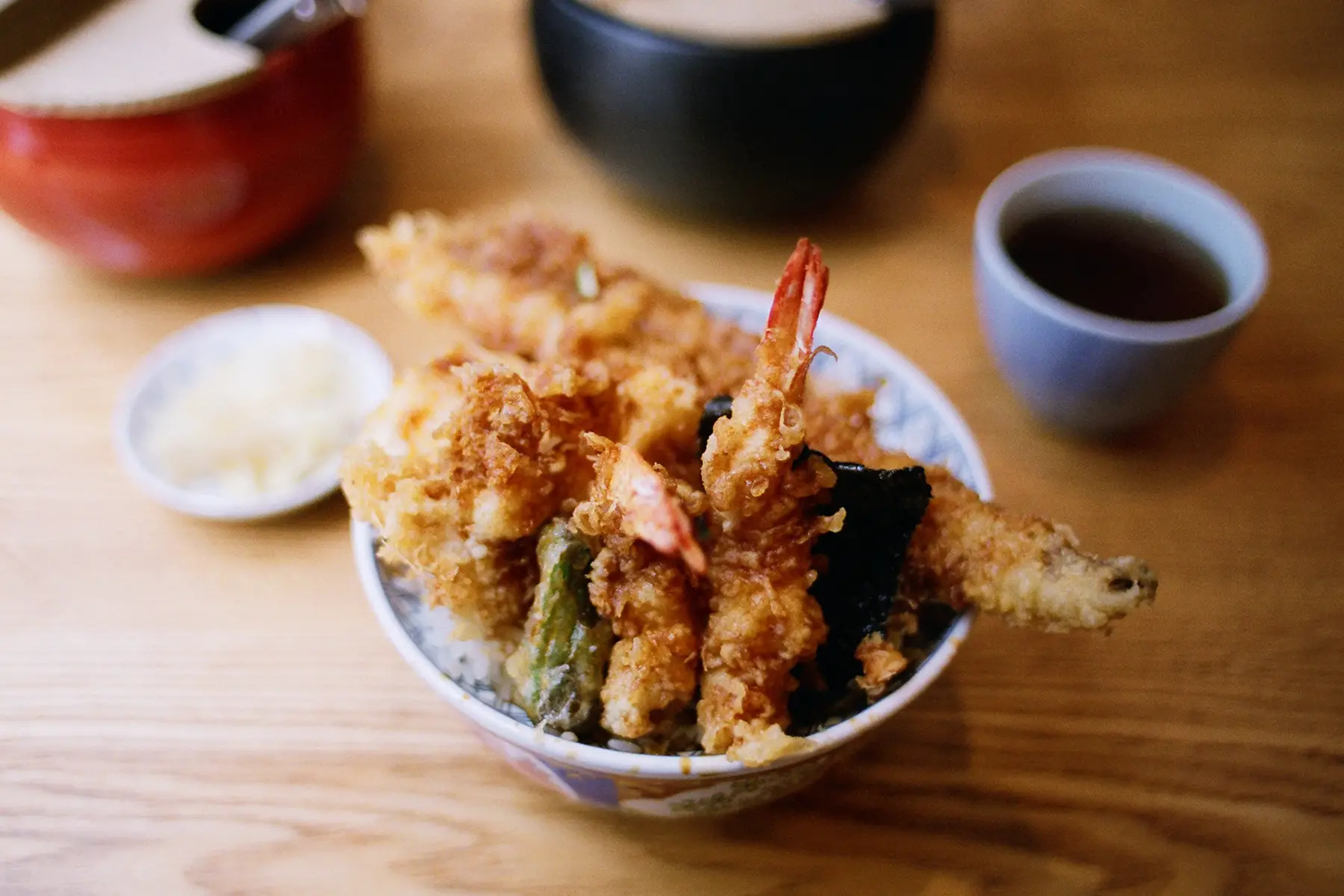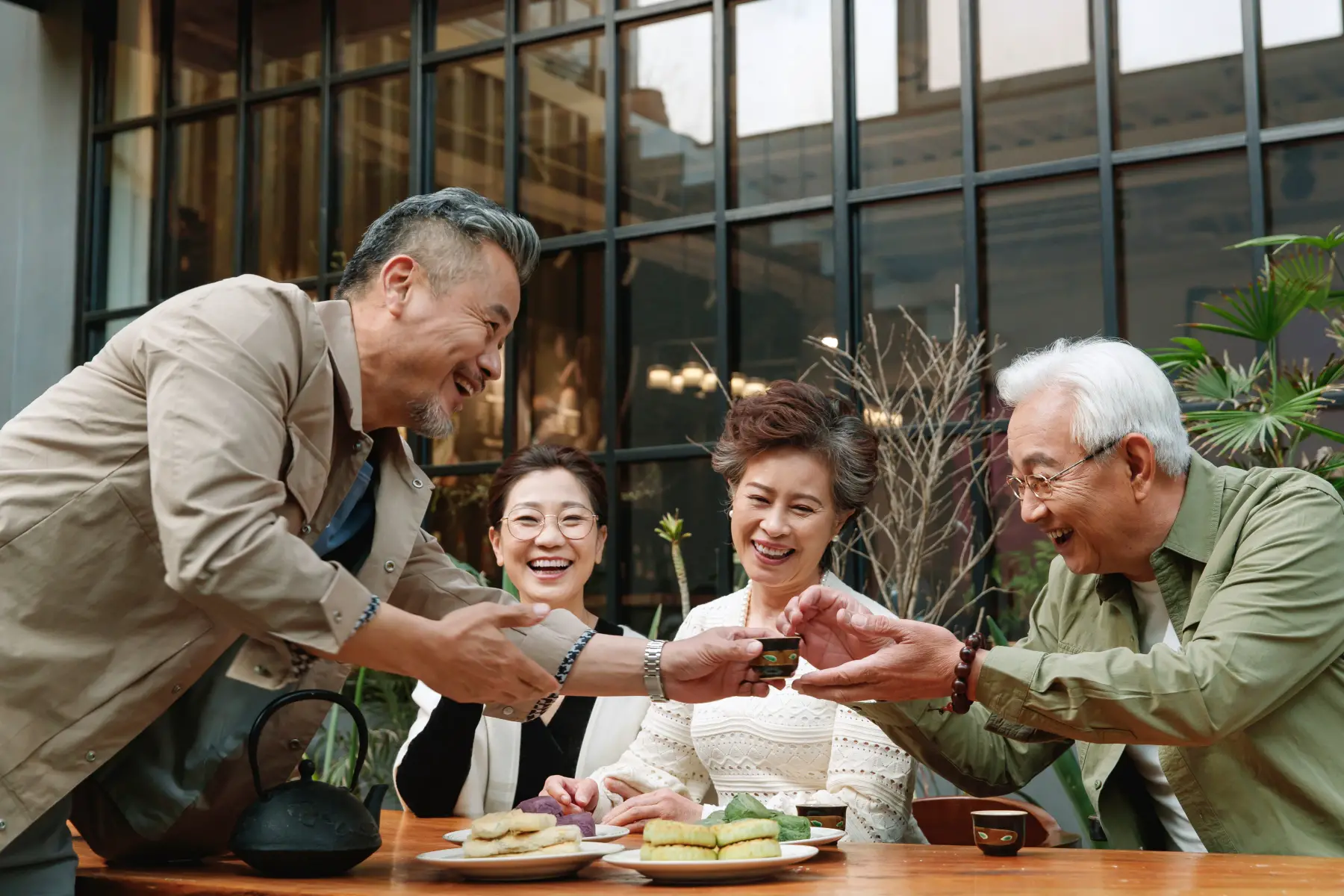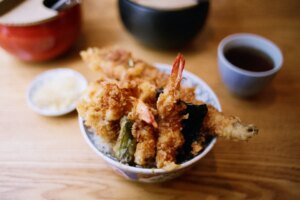Over the past few decades, Japanese food has become popular globally. The country’s diet has a reputation for being not only tasty but pretty healthy and nutritious, too, incorporating a wealth of fresh, seasonal ingredients.
If you’re moving to Japan, sampling the rich and varied cuisine (料理, ryori) is one of the most exciting aspects of the local culture. And once you’ve read about the different types of food available, why not try making your own favorite Japanese recipes?
Here’s a detailed look at Japanese cuisine to whet your appetite, with sections on:
Japanese cuisine
The traditions surrounding Japanese cuisine are so notable that UNESCO has recognized them as intangible cultural heritage.
Although most people outside Japan associate it with a handful of well-known dishes, such as ramen, sushi, and katsu curry, the country’s culinary tapestry is rich and diverse, with many regional twists.
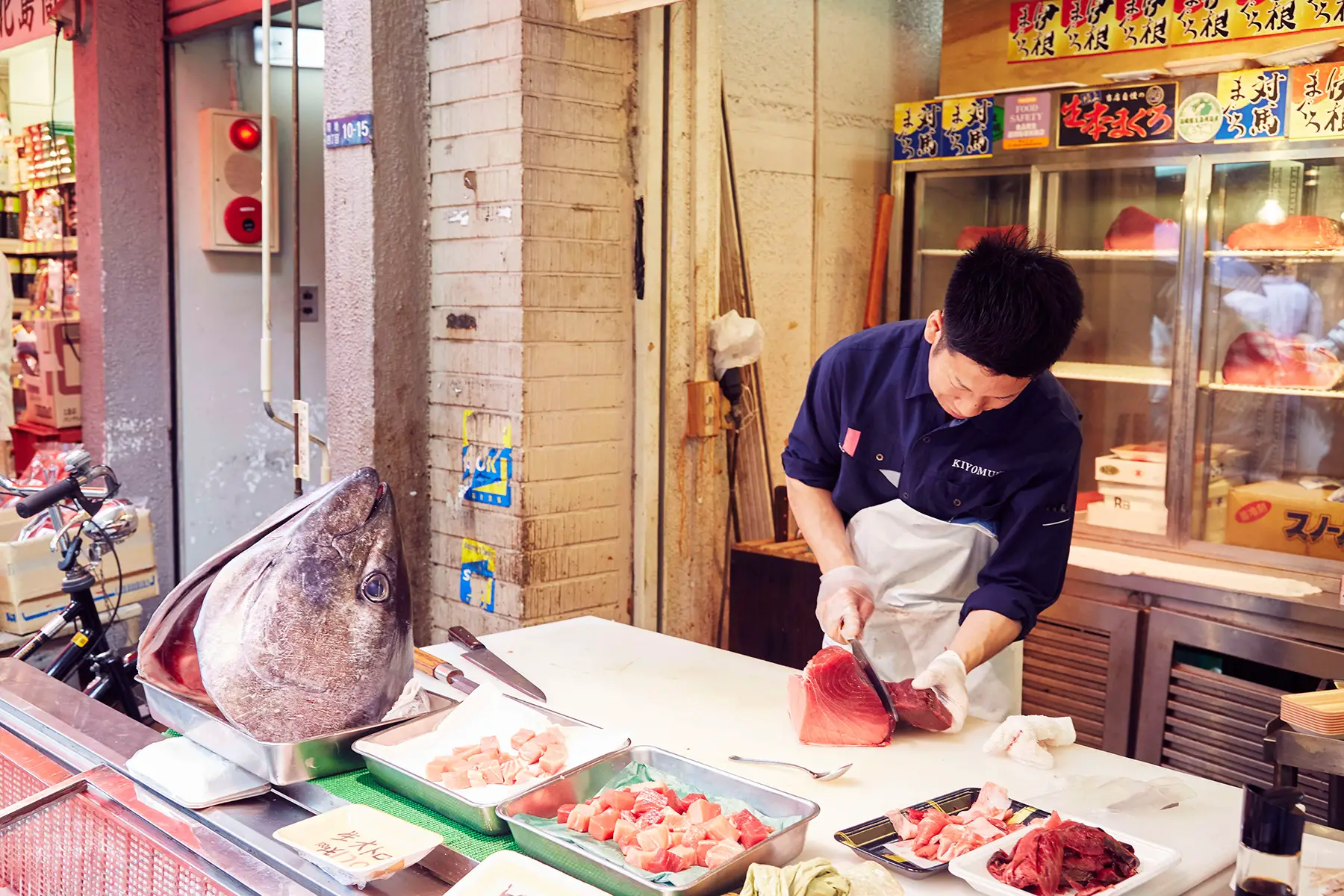
Washoku usually means combining a staple dish, such as white rice or noodles, with a small number of side dishes. These accompaniments typically consist of meat, seafood, vegetables, or soybeans such as tofu or edamame, and they are plated separately rather than mixed.
People often serve these meals with soup, pickles, and various condiments.
Seasonality is essential to the Japanese diet. Therefore, many meals consist of local, freshly sourced produce and vary according to the time of year.
Notably, processed foods and ingredients are less common than in other countries. Because of this, health and wellness brand Healthline ranks Japan’s cuisine as the second-healthiest in the world after Greece, with its low amounts of saturated fat and high rate of fish consumption.
In addition to being healthy, Japanese food is considered some of the best in the world. Japan has the second-highest number of Michelin-starred restaurants in the world after France. Its capital city, Tokyo, has more 3-star Michelin restaurants than any other city globally.
History and influences
Many aspects of Japanese cuisine have roots and influences from Chinese food traditions. For example, one of the most recognizable implements, the chopstick, originally came from China.
Many types of food are also thought to have come to Japan from there. Rice, for example, probably came from China around 2,400 years ago. Meanwhile, noodles arrived around the eighth century.
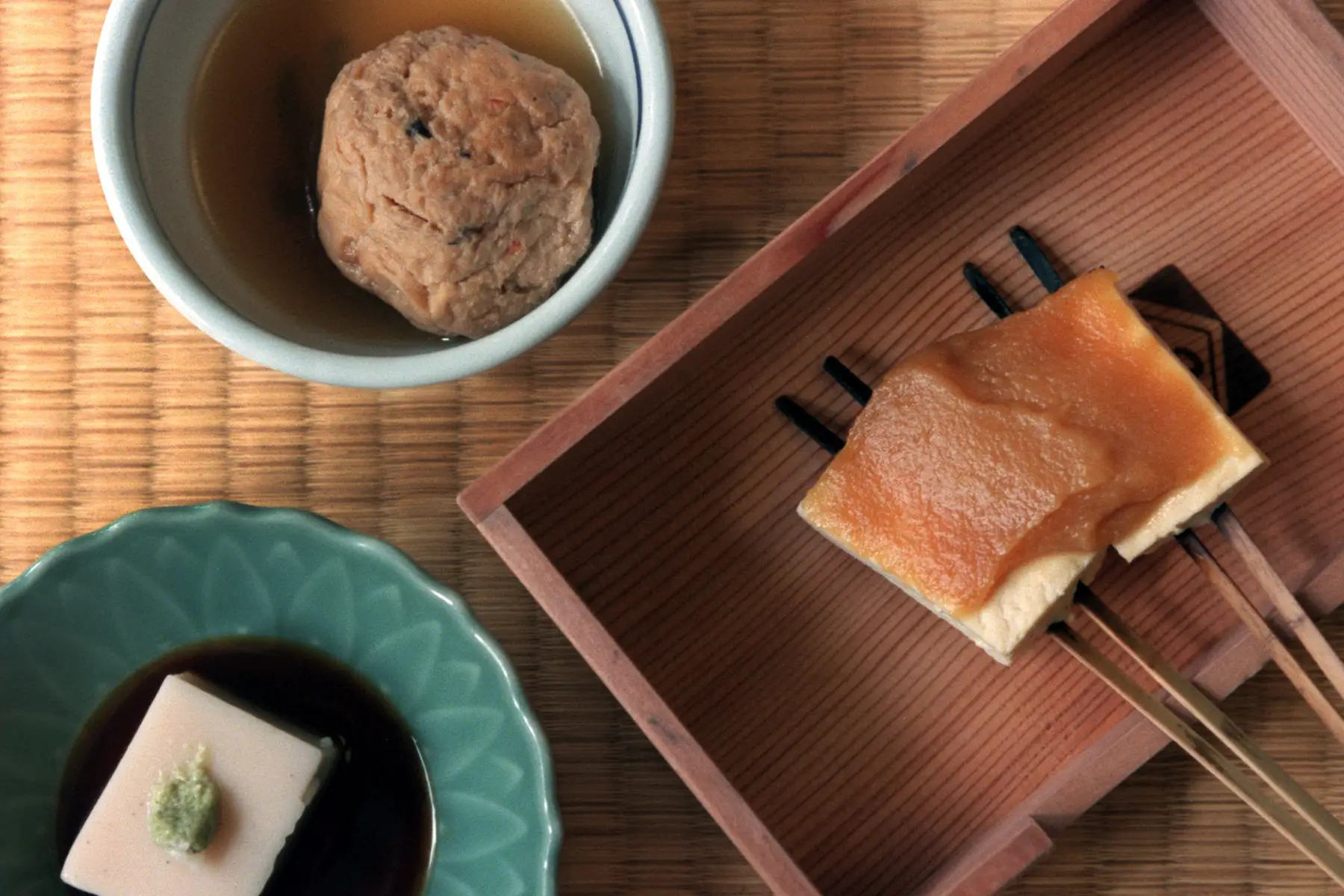
Other Japanese staples originating in China include buckwheat, barley, soybeans, soy sauce (醤油), and miso paste (味噌).
Japan became a largely vegetarian society around the sixth century AD, towards the end of the Kofun period when Buddhism became the main religion. During this period, fish became a primary part of the Japanese diet, thanks to the country’s island location. Moreover, this locally sourced food was affordable and nutritious.
Sushi (寿司), one of Japan’s most popular gastronomic exports, originated in the 15th century to fish. People would ferment the fish in vinegar, rice, and salt. However, hand-rolled sushi (手巻き寿司) became popular during the Edo period in the 19th century.
The Japanese population was officially allowed to eat meat again during the Meiji Restoration in the 19th century when Japan opened up to other countries. International culinary influences in Japan include the popularization of bread and chocolate, and the following foods now appear on Japanese menus:
- Tempura (天ぷら) from Portugal
- Curry (カレーライス) from India, via the UK
- Taco rice (タコライス, takoraisu) from Mexico. It’s made with taco-flavored beef served with rice became popular in the 1980s.
The typical Japanese diet
The standard Japanese diet consists of three meals a day – breakfast, lunch, and dinner. Each meal usually includes:
- Staple food: For example, rice or noodles
- Side dishes: Typically two or three dishes comprising meat, seafood, vegetables, or soybeans
- Soup: Usually a miso soup (味噌汁), but can be other types
The Japanese diet usually blends five distinct tastes – sweet (甘味), salty (塩味), sour (酸味), bitter (苦味), and umami (旨味) – throughout daily meals.
Breakfast
The traditional Japanese breakfast differs from breakfasts in places such as Europe and the United States. It follows a similar pattern to other meals and typically consists of:
- Staple: Usually steamed rice
- Soup: Generally a miso soup
- Protein dish: Normally fish, boiled egg, tamagoyaki, or natto
- Side dish: For example, pickled vegetables, fruit, dried seaweed (海苔), or a salad
Although this may sound heavy for a meal at the start of the day, the portion sizes are manageable. In addition, fried foods are not popular for breakfast. Most people drink green tea to accompany their breakfast, but others have water or juice.
While this is the traditional Japanese breakfast, nowadays, some people incorporate international influences or take shortcuts on busy days. For example, rice is often eaten as a porridge or blended with other ingredients to form rice balls, or onigiri (おにぎり). Toast has also become more popular as a quick breakfast, often with jam or margarine.
The Japanese typically like to eat breakfast early, around 06:00–07:00.
Lunch
Lunch in Japan usually takes place from 12:00–13:00 and follows a similar structure to breakfast. This meal usually consists of rice with a side of miso soup. Accompanying this will be a main side dish (e.g., seafood, tofu, beef, tonkatsu, tempura, or Japanese curry) and smaller portions of vegetables, salads, or pickles.
You can eat this in Japanese restaurants as a set meal and choose your options. Sometimes, you can add noodles to the broth as the staple or choose a different soup option (clam, for example).
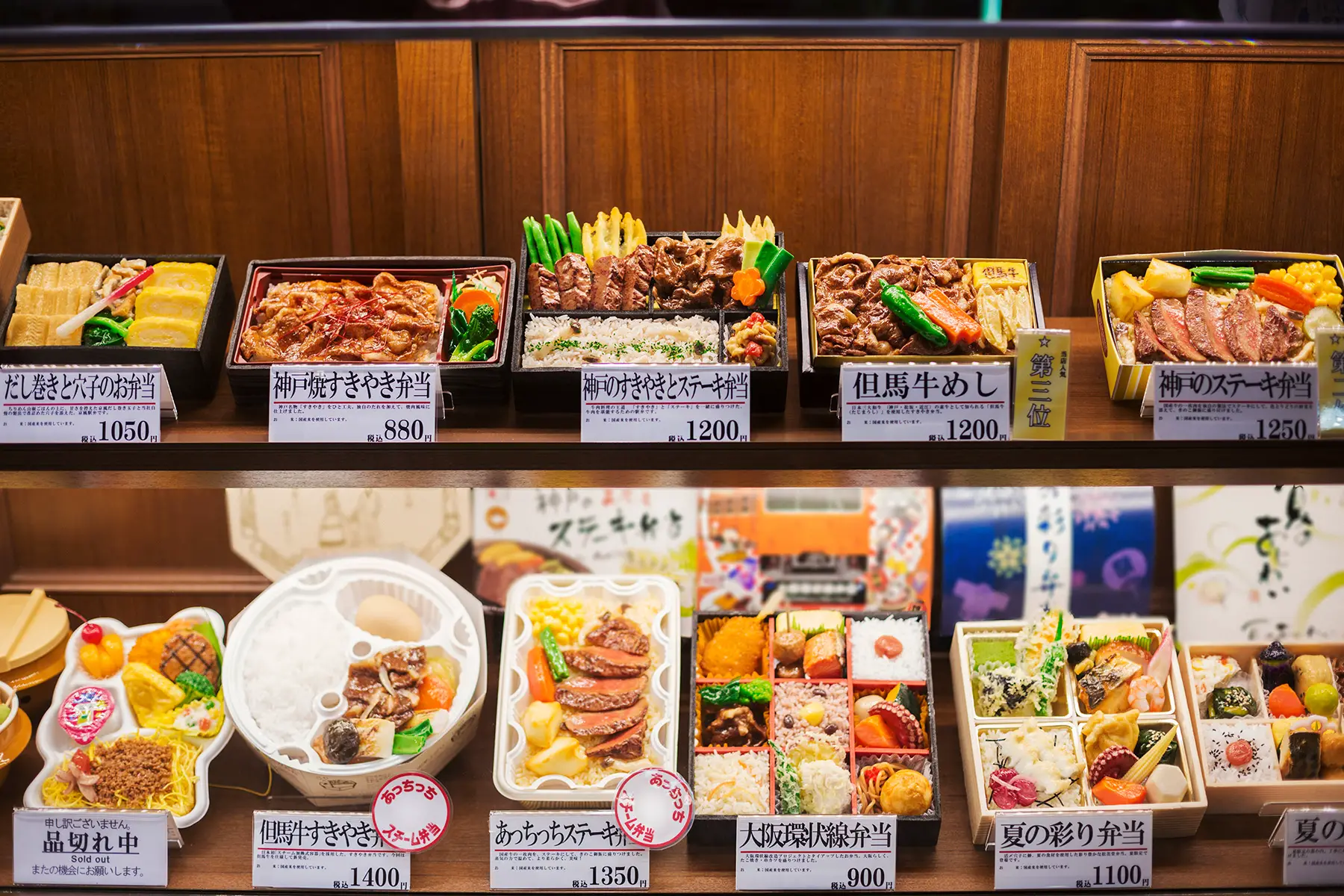
Single-dish meals have become more popular in Japanese restaurants and takeaway stalls. They are easier and quicker to prepare if you want a hearty meal but are short on time. These options include:
- Bento (弁当): A pre-prepared lunch box sold at Japanese food stores, typically containing rice or noodles with a mix of meat, fish, tofu, vegetables, salad, and sometimes a condiment or dressing
- Noodles: Popular types in Japan are soba, udon, and ramen (ラーメン); these noodles are often served in a broth or with sides such as tempura or gyoza dumplings (餃子)
- Rice bowls (丼ぶり): Bowls of rice served with ingredients such as fish, meat, or vegetables that have been simmered together; popular choices include beef and tuna
Japanese lunches are usually accompanied by a beverage such as tea or water.
Dinner
A Japanese dinner is similar to lunch but often more elaborate, longer, and followed by a dessert. Dinnertime in Japan is normally around 18:00–20:00.
The meal structure is typically two-course, with the first (main) course consisting of several dishes served at once. Similar to other meals in Japan, the dinner usually consists of:
- Staple: Usually rice or noodles
- Soup: For example, miso shiru or sumashi jiru
- Protein: Vegetables, pickles, salads
If you’re in a restaurant, you might also have a second course, dessert, which comes straight after dinner. This could be anything from sweet rice cakes to ice cream. Popular beverages at dinnertime in Japan include tea, beer, water, or sake (酒).
Snacks
Japan has many snack foods you can buy from grocery stores, convenience stores, or supermarkets. These include globally popular ones, such as candy, crisps, chocolate, biscuits, and rice cakes, but you’ll also find local treats, including:
- Dorayaki (どら焼き): A sweet red bean paste filling between two small pancakes
- Mochi (もち): A type of sweet rice cake shaped into a small bun
- Senbei (煎餅): A toasted rice cracker
- Karinto (かりんとう): A deep-fried snack made from flour, yeast, and brown sugar, resembling a small sausage
- Arare (あられ): A bitesize Japanese rice cracker flavored with soy sauce
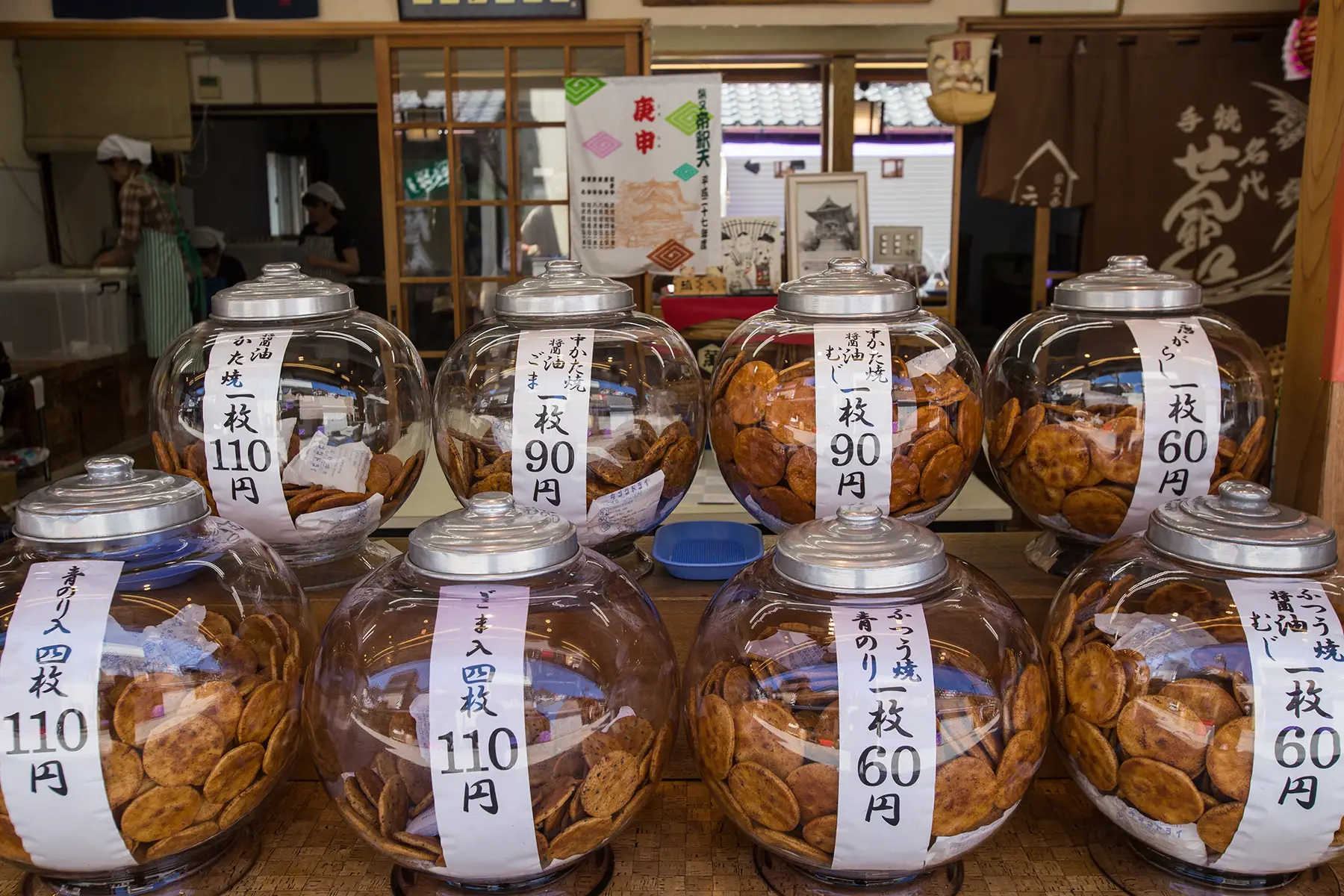
Other popular savory snacks include nuts and toasted corn.
Special meals in Japan
Japan has numerous festivals (祭, matsuri), special occasions, and public holidays, and people commemorate most of them with a special meal. Many of these vary by region.
New Year
Unlike many of its neighbors, Japan celebrates New Year (正月) at the start of January.
People usually begin the year by enjoying a festive meal with close family – usually on New Year’s Day, but it can also take place a couple of days afterward. The special New Year meal is usually pre-prepared and stored in sealed boxes, similar to bento.
That’s because, in Japan, the start of the year should be a relaxing period involving minimal work, and this includes cooking.
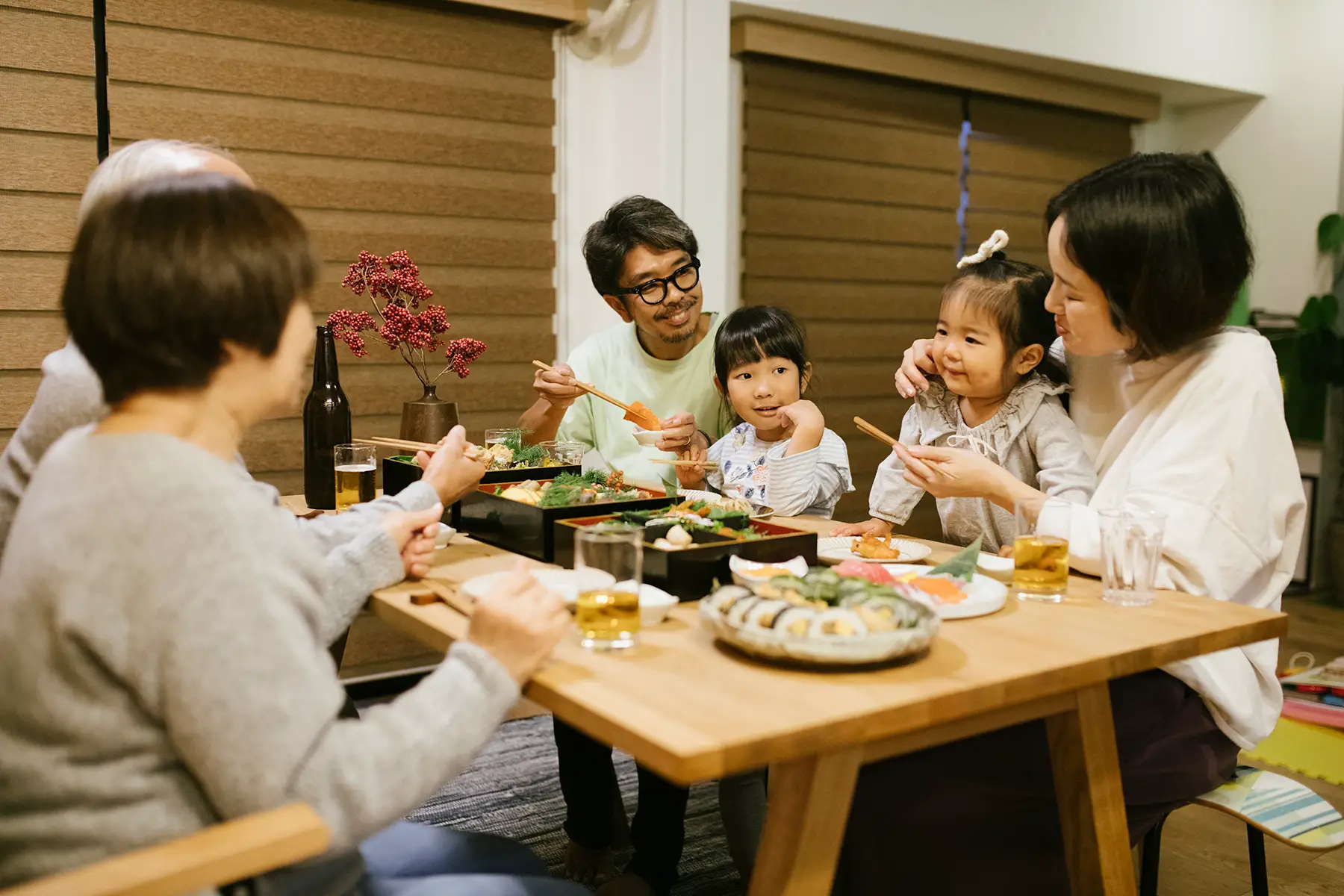
The Japanese New Year feast is varied and popular ingredients include shrimp, fish cakes, omelets, chicken, vegetables, daikon (winter radish), and carrot salad. Meals are often accompanied by ozoni, a Japanese soup with vegetables and rice cakes.
Another special day at the start of the Japanese year is Jinjitsu no Sekku (人日の節句) on 7 January. This is the first of the five traditional seasonal festivals in Japan. It’s known as the feast of the seven herbs (七草粥), as people eat a rice porridge made with seven different herbs to help ward off evil spirits.
Girls’ Day
Also known as Doll’s Day, Hina-matsuri (ひな祭り), or Momo no Sekku (桃の節句), Girls’ Day is the second of the five traditional seasonal Japanese festivals. It occurs each year on 3 March when the peach trees are in full blossom.
On this day, families decorate their homes with dolls and make wishes for young girls in the household to grow up healthy.
Traditionally, a small meal is prepared consisting of a sushi dish called chirashi-zushi, a clam soup, arare rice crackers, and pink, white, and green mochi cakes.
Children’s Day
Boy’s Day, or Tango no Sekku (端午の節句), has many different names. It is also known as the Iris Festival (菖蒲の節句), and it has also been known as Children’s Day (こどもの日) since 1948, and celebrates all children regardless of gender.
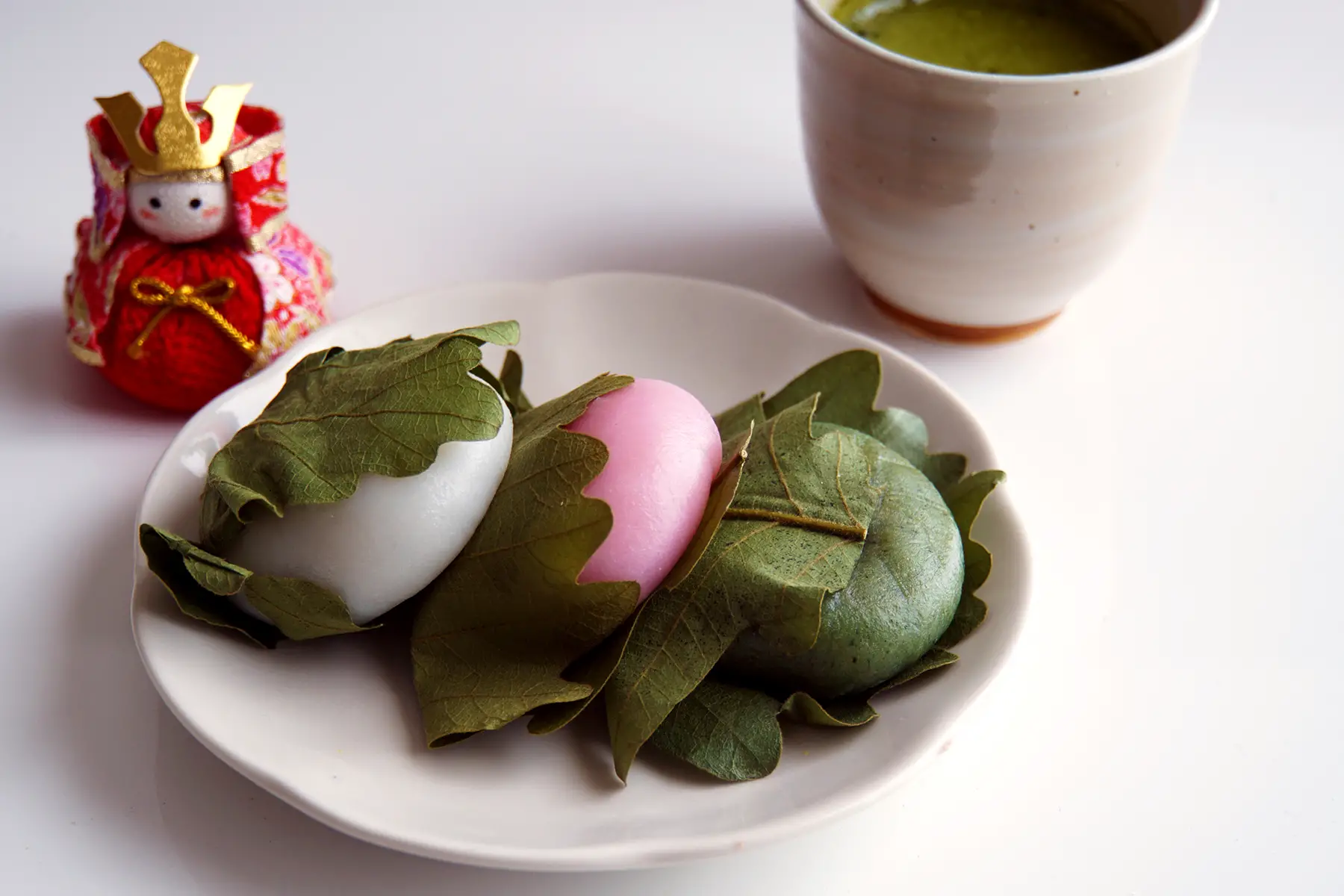
It takes place on 5 May and is the third of the five seasonal festivals. Like Girls’ Day, people make wishes for children’s health and prosperity.
Japanese cuisine consumed on this day includes kashiwa-mochi, sweet bean paste-filled rice cakes wrapped in oak leaves, and chimaki, steamed rice cakes wrapped in bamboo leaves.
Midsummer Day of the Ox
The Midsummer Day of the Ox (土用の丑の日) differs each year in Japan, but it is usually on or around the hottest day of the year, in late July or early August. The day is set for 30 July in 2023.
Although it originally came from the Chinese Zodiac, the celebration in Japan has developed over the years to involve eating eel. According to many accounts, this began due to a superstition that eating food starting with the letter u (う) would bring relief from the intense heat and humidity.
Families typically eat kabayaki on this day, roasted eels in a sweet and spicy sauce. This is usually served with a bed of rice as a donburi. Different regions vary in their preparation and presentation of the dish.
Autumn Moon Festival
The Autumn Moon Festival is also known as the Night of the Harvest Moon (十五夜 or 中秋の名月) in Japan. This annual event heralds in the Harvest Moon in late September or early October.
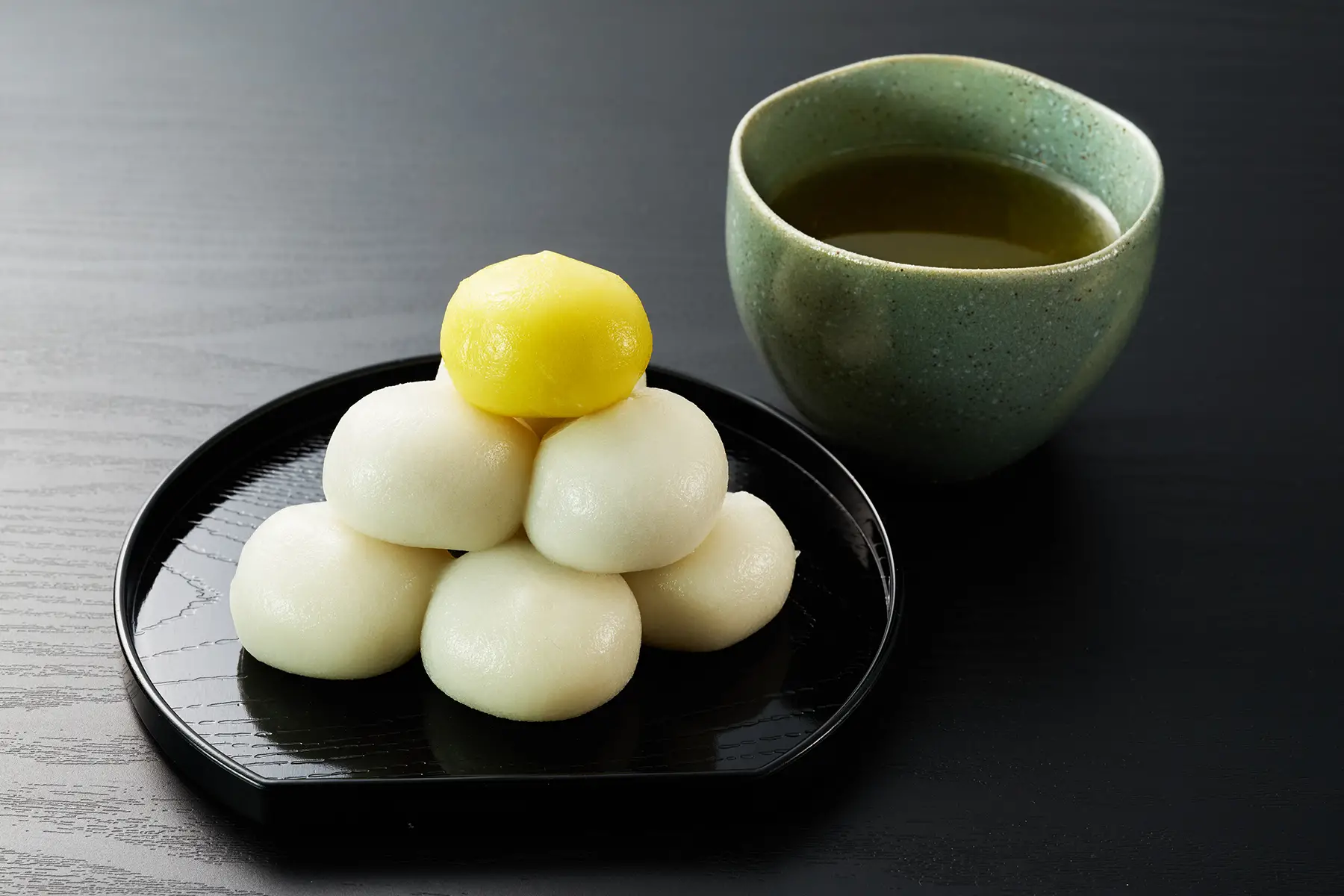
It’s common for people in Japan to hold moon-viewing parties (お月見) where rice balls are served.
New Year’s Eve
New Year’s Eve (大晦日) is an important celebration in the Japanese calendar. On this day, families and groups of friends gather to say goodbye to the current year and welcome a prosperous new one.
People commonly serve up toshikoshi-soba, a soba noodle dish with soy sauce and mirin, served with green onions. This Japanese tradition dates back to the Edo period. Soba noodles are used because they are thin and break easily – they symbolize breaking ties with bad luck from the previous year.
What are the typical ingredients used in Japanese cuisine?
Japanese cooking revolves around the seasons, meaning you may see certain ingredients in shops or supermarkets for just a few weeks or months of the year. You’ll also find a variety across the different regions, as many have specialties.
Here is a breakdown of the most common ingredients in Japan.
Meat
The average person in Japan consumes around 42.1kg of meat (肉) per year, which is below the Organisation for Economic Cooperation and Development (OECD) average of 71.6kg (2021).
The Japanese diet contains little red meat – the country was pescatarian for over 1,000 years, and eating meat only became common again in the late 19th century. Processed foods such as burgers and sausages are not common outside of imported global brand outlets.
The most popular meats in Japan are:
- Chicken (鶏肉)
- Pork (豚肉)
- Beef (牛肉) – especially Wagyu (和牛) such as Kobe beef (神戸肉)
You might also come across horse meat (馬肉) on Japanese menus, but it is not hugely popular.
Well-known Japanese dishes include:
- Basashi (馬刺し) – raw horse meat sashimi
- Chicken Katsu (チキンカツ)
- Chicken Teriyaki (チキン照り焼き)
- Gyudon (牛丼)
- Shabu Shabu (しゃぶしゃぶ)
- Tonkatsu (トンカツ)
- Yakitori (焼き鳥)
Fish and other seafood
As a relatively small island nation, Japan is one of the world’s biggest fish consumers. It has so many specialties and seafood (魚介) restaurants because of each region’s access to fresh marine supplies.
Some of the main fish varieties are:
- Bonito (カツオ)
- Eel (うなぎ)
- Mackerel (サバ)
- Pufferfish (フグ) – be careful! can be poisonous
- Salmon (サケ)
- Sea Bream (タイ)
- Tuna (マグロ)
- Yellowtail (ブリ)
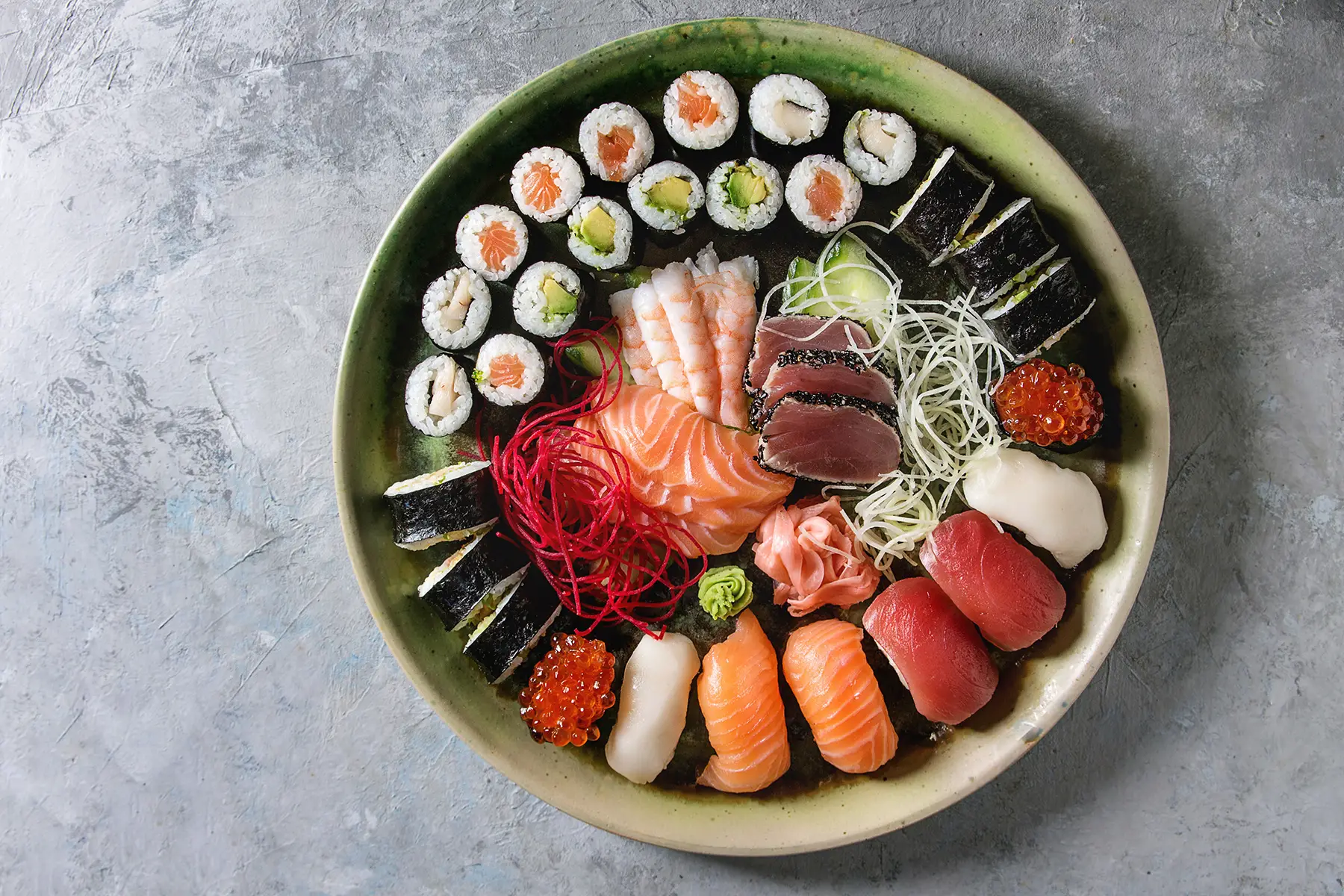
Other popular seafood types include:
- Clam (ハマグリ)
- Crab (カニ)
- Lobster (ロブスター)
- Octopus (タコ)
- Oyster (カキ)
- Shrimp (エビ)
- Squid (イカ)
Seafood dishes you can expect to see prepared in Japan or on restaurant menus include:
- Himono (干物)
- Hitsumabushi (ひつまぶし)
- Nigirizushi (握り寿司) – hand-pressed sushi
- Sashimi (刺身) – raw, sliced fish
- Takoyaki (たこ焼き)
- Tendon (天丼)
Vegetables
Japan consumes a wide variety of seasonal vegetables (野菜) used in different dishes depending on the time of year. Most traditional Japanese meals will include at least one vegetable-based dish or a salad, or these will be blended into a sauce to accompany the main dishes.
A study in 2015 (in Japanese) by the Ministry of Health, Labour, and Welfare (MHLW) showed that the most popular vegetable in Japan is the daikon (大根). This was followed by the onion (タマネギ) and the cabbage (キャベツ). Other vegetables that Japanese diners often consume include:
- Bean sprout (もやし)
- Carrot (にんじん)
- Lotus root (レンコン)
- Pumpkin (かぼちゃ)
- Spinach (ほうれん草)
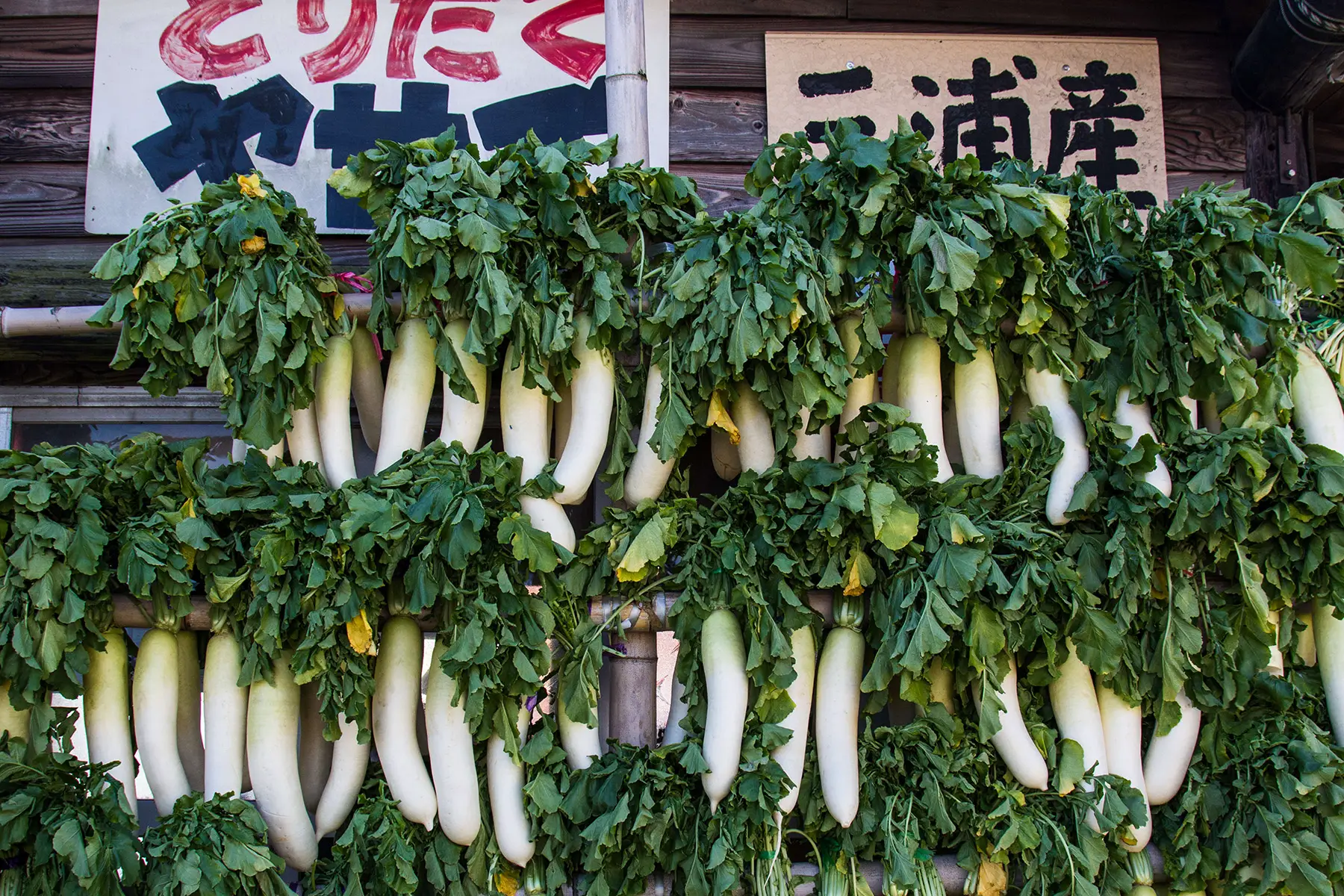
It is also common in Japan to pickle vegetables and eat them as a side dish (漬物). Popular examples are:
- Pickled plums (梅干し)
- Pickled radishes (たくあん)
- Rice bran pickles (ぬか漬け)
- Lightly pickled vegetables (浅漬け)
Fruit
People in Japan commonly eat fresh fruit (フルーツ), either on its own or as part of a salad or dessert. Apples (りんご) and oranges (オレンジ) are the two most popular fruits. There are several well-known varieties, such as the mikan (みかん) orange.
Other popular fruits include:
- Cherries (さくらんぼ)
- Lemons (レモン)
- Melons (メロン)
- Persimmons (柿)
- Plums (梅)
- Strawberries (いちご)
There are also a number of hybrid citrus fruits, such as yuzu (柚子) and amanatsu (甘夏).
Other plant-based foods
There are a couple of other plant-based foods that you’ll almost certainly come across when trying Japanese cuisine. One is soybean, particularly tofu and edamame. Tofu is made from soy milk and is a popular vegetarian meat substitute due to its versatility.
It is a common ingredient in miso soup and is also used in yudofu (湯豆腐) and many hot pot dishes (鍋料理). Edamame are young soybeans that are often eaten with seasoning as an appetizer before Japanese meals. They also sometimes feature in salads and stir-fries.
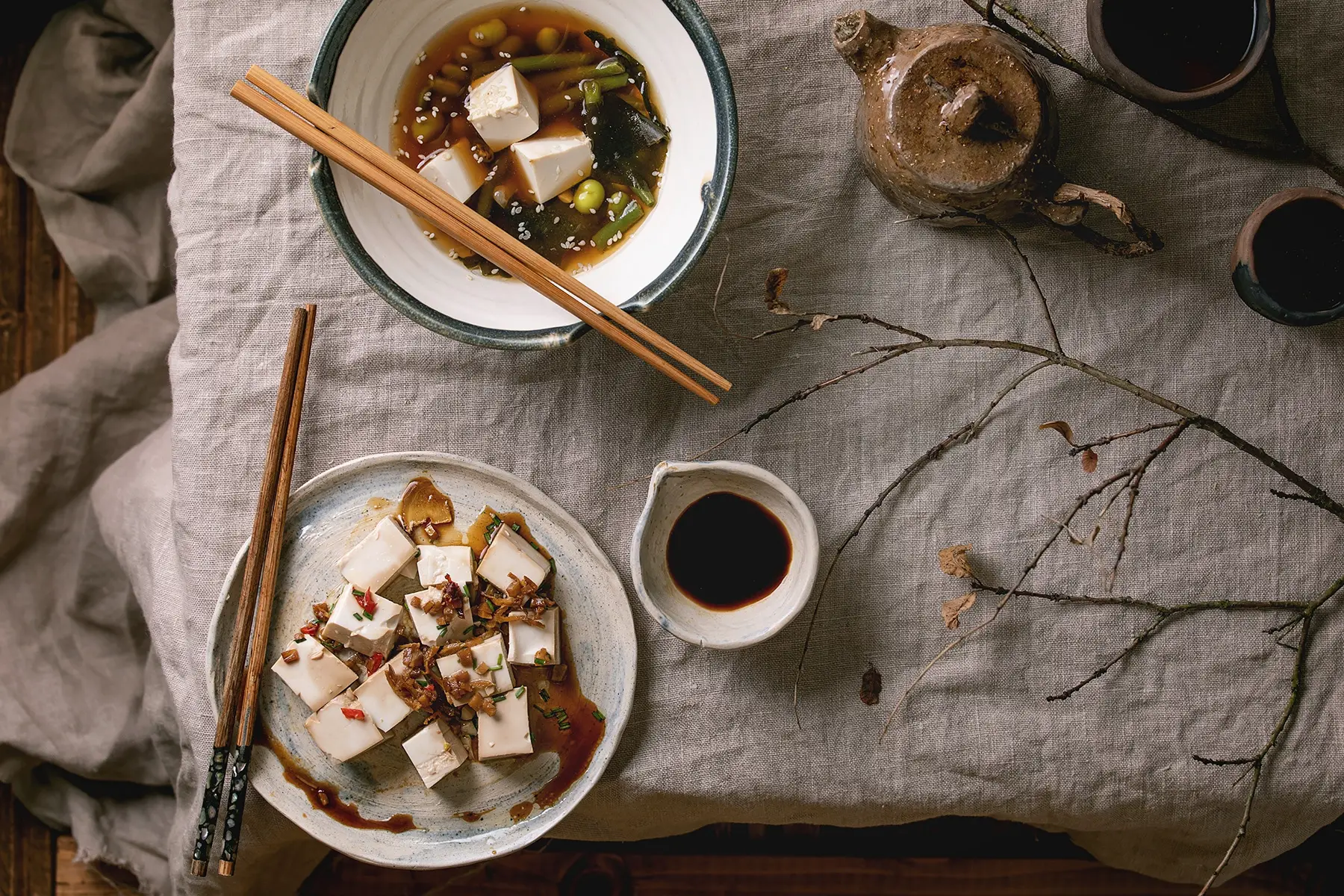
Seaweed (海藻) is also popular in Japan – people eat it as a snack and in sushi, salads, and soups. This plant is rich in nutrients and minerals and has an umami taste, which is an important component in several Japanese recipes. Seaweed flakes (青のり) are often sprinkled over grilled and fried food and stir-fries.
Carbohydrates
Japan’s basic diet is high-carb and low-fat. The country has the lowest obesity rates in the OECD region, partially because carbs are prepared with minimum cooking in fat or oils. They are also often consumed with large quantities of fish and vegetables.
Rice is by far the most widely-consumed carbohydrate in Japan and features in much of the country’s diet. The most popular types include short grain and mochi rice, with popular dishes including sushi, gyūdon, and katsu.
Noodles are another staple; udon and soba are the two most popular types, and ramen noodle dishes are one of Japan’s most famous culinary exports. Starchy vegetables such as potatoes, yams, and sweet potatoes are also used in Japanese cooking.
Bread is less common, although it has become more widespread as the country has experienced influences from Western cuisine.
Cheese and dairy products
Japan is not a large dairy consumer, especially compared with Europe. That said, eggs (卵) feature in many dishes, for example, omelet, oyakodon, and tamagoyaki. Boiled eggs are also often added to variations of Japanese dishes such as noodles.
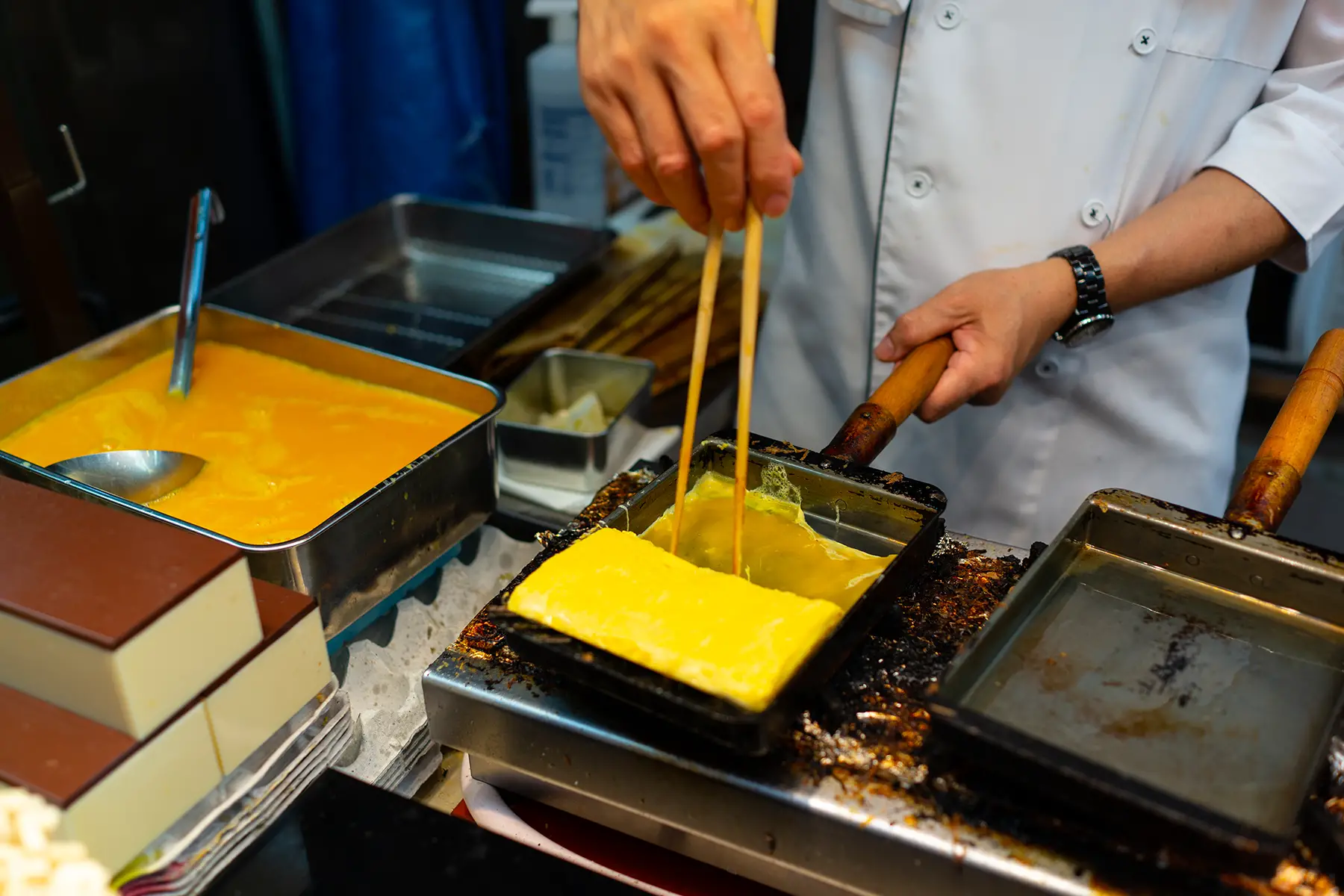
Cheese (チーズ), on the other hand, is not as popular. That’s not to say that you won’t find them anywhere in the country. The Hokkaido region of Japan produces sakura soft cheese, and you can buy foreign varieties, such as Camembert and Danish Blue, in many Japanese supermarkets. Restaurants and supermarkets also sell pizzas with cheese.
On the other hand, you may come across milk (牛乳) – many Japanese schools offer it to children with their school lunches. However, plant-based milks (e.g., soy and almond) are becoming more popular.
Herbs and spices
Japanese cuisine involves many herbs and spices (香辛料). The most famous is probably wasabi, a Japanese horseradish with a similar kick to hot mustard. This is often used to make a condiment for sushi and sashimi and is a feature of dishes like kamaboko seafood and ochazuke .
Other popular Japanese spices include:
- Ginger (生姜) and Japanese ginger (ミョウガ): Used in tofu dishes, udon noodles, tsukemono, miso soup, and ginger pork
- Karashi (からし – Japanese mustard): Added to meals such as karashi renkon
- Mitsuba (三つ葉 – Japanese parsley): Used in chawanmushi, oyakodon, tamagoyaki, and somen noodles
- Sansho pepper (山椒): Sprinkled on many foods similar to black pepper and used in unagi dishes
- Shiso (シソ – Japanese basil): Often used with fish, tempura, sashimi, and umeboshi
- Shichimi togarashi (七味唐辛子 – Japanese seven spice): Often added to noodles, gyudon, yakitori, and hot pot dishes
Sauces and condiments
The Japanese kitchen features a wide range of sauces, oils, pastes, and other condiments typically added after cooking or as a dipping accompaniment. Some of the most common ones are:
- Soy sauce (醤油): Made from fermented soybeans, this sauce was originally imported from China and is the most commonly used condiment in Japan
- Ponzu sauce (ポン酢, ponzu): Made with soy sauce mixed with citrus fruit, this is a popular Japanese dipping sauce for a range of meals
- Wasabi (わさび): Often ground into a paste and consumed as a condiment with sushi, sashimi, and grilled food
- Tonkatsu sauce (トンカツソース): Thick, fruity brown sauce slightly similar to BBQ sauce, often added to katsu curry or used as a dipping sauce for street food
- Miso (味噌): Fermented soybean paste used in much Japanese cooking but also available as a sauce or for dipping
- Dashi (出汁): The quintessential broth stock for the likes of hot pots and noodle soups, also available as a sauce
- Mirin (みりん): Also known as sweet rice wine, this is a syrupy seasoning and glazing agent, often added to salads
- Rice vinegar (米酢): Sometimes offered as an optional addition to Japanese cuisine but also used to prepare food such as sushi
- Bonito flakes (かつお節): Shaved fish flakes sprinkled on salads, soups, and various other dishes in Japan
- Japanese mayonnaise (マヨネーズ): A western-influenced condiment used with some salads and or as a topping for street food such as okonomiyaki and takoyaki
Most famous dishes in Japan
As you’ve probably gathered, Japan is home to a whole host of gastronomic delights. Here is a very brief rundown of some of the most well-known dishes:
- Sushi: Arguably Japan’s most famous culinary export – vinegared rice is shaped into bitesize portions with fish and vegetables. Ingredients can come as a topping on the rice or rolled inside it. The pieces are often wrapped in dried seaweed.
- Ramen: Noodle soup made with a variety of different flavors and ingredients
- Sashimi: Thinly-sliced raw fish or seafood, usually served with a salad and dipping sauces
- Gyoza: Filled, crescent-shaped dumplings made with flour, eggs, and water, served with a dipping sauce
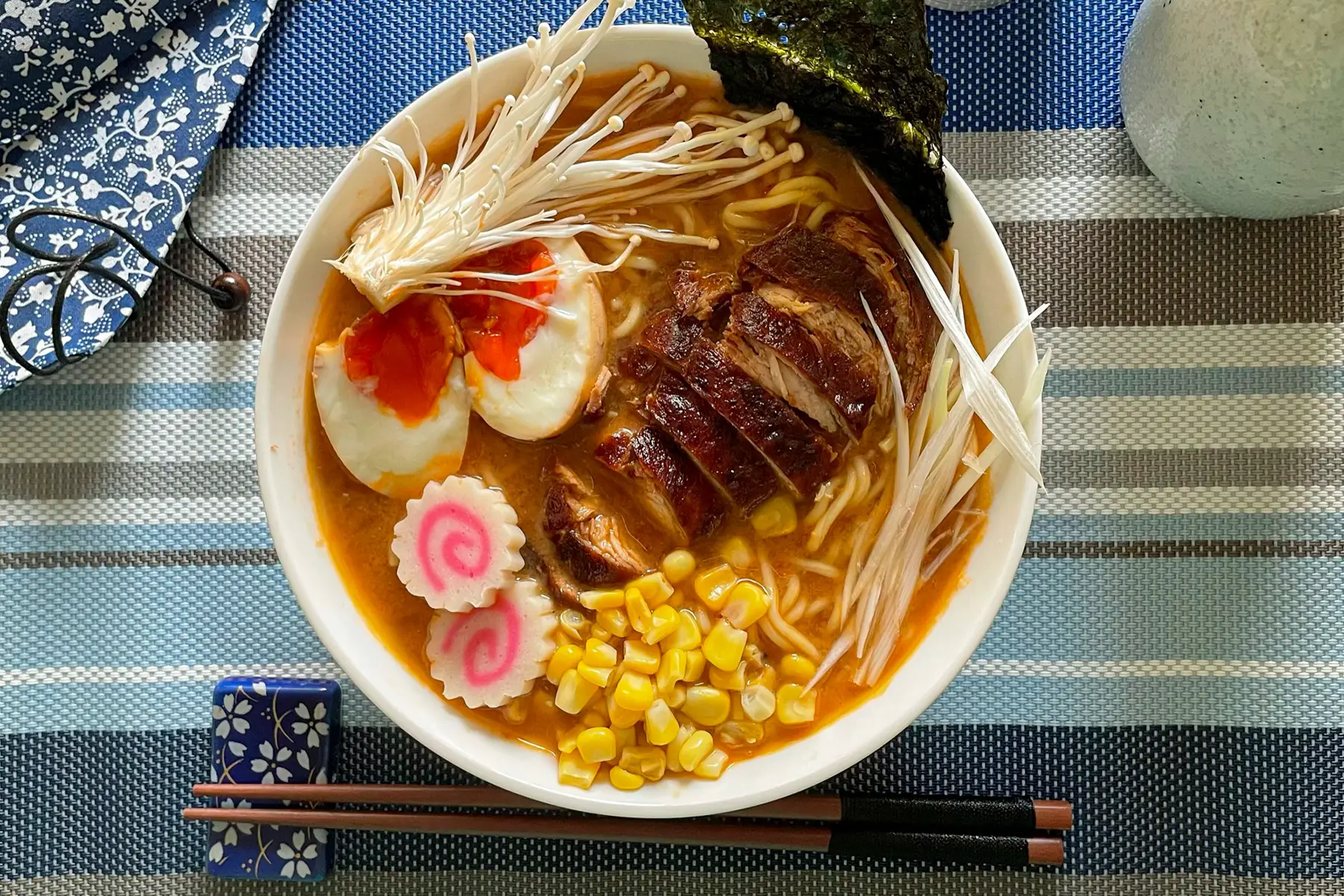
These recipes can be made with a range of ingredients, and many regions put their own spin on them.
In addition, there are many famous cooking methods in Japan, such as teriyaki. This involves marinating ingredients, usually meat or fish, in a soy, mirin, and sugar sauce and broiling, roasting, or grilling it.
Most famous desserts in Japan
Diners with a sweet tooth will be happy to discover that Japan is home to many delicious desserts. These are often small and snack-size, in keeping with the Japanese diet’s tradition of moderation.
Matcha (抹茶) is a very distinct flavor that you might come across in Japanese desserts. This green powdered tea is an acquired taste found in a range of sweet dishes, including ice cream, biscuits, and cakes.
Other famous Japanese desserts include:
- Chagashi (茶菓子): Small, sweet cakes made from ingredients like grains and azuki beans, often served with Japanese tea
- Daifuku (大福): Small cakes made with a mochi shell and a sweet, creamy filling – most commonly red bean paste
- Dango (団子): Rice flour and sugar dumplings on a skewer with a sweet glaze
Regional differences in Japanese cuisine
Much of Japanese cuisine is highly regional. One of the most notable distinctions is how two different areas use red meat – Kanto is mostly pork-based, and Kansai is primarily beef.
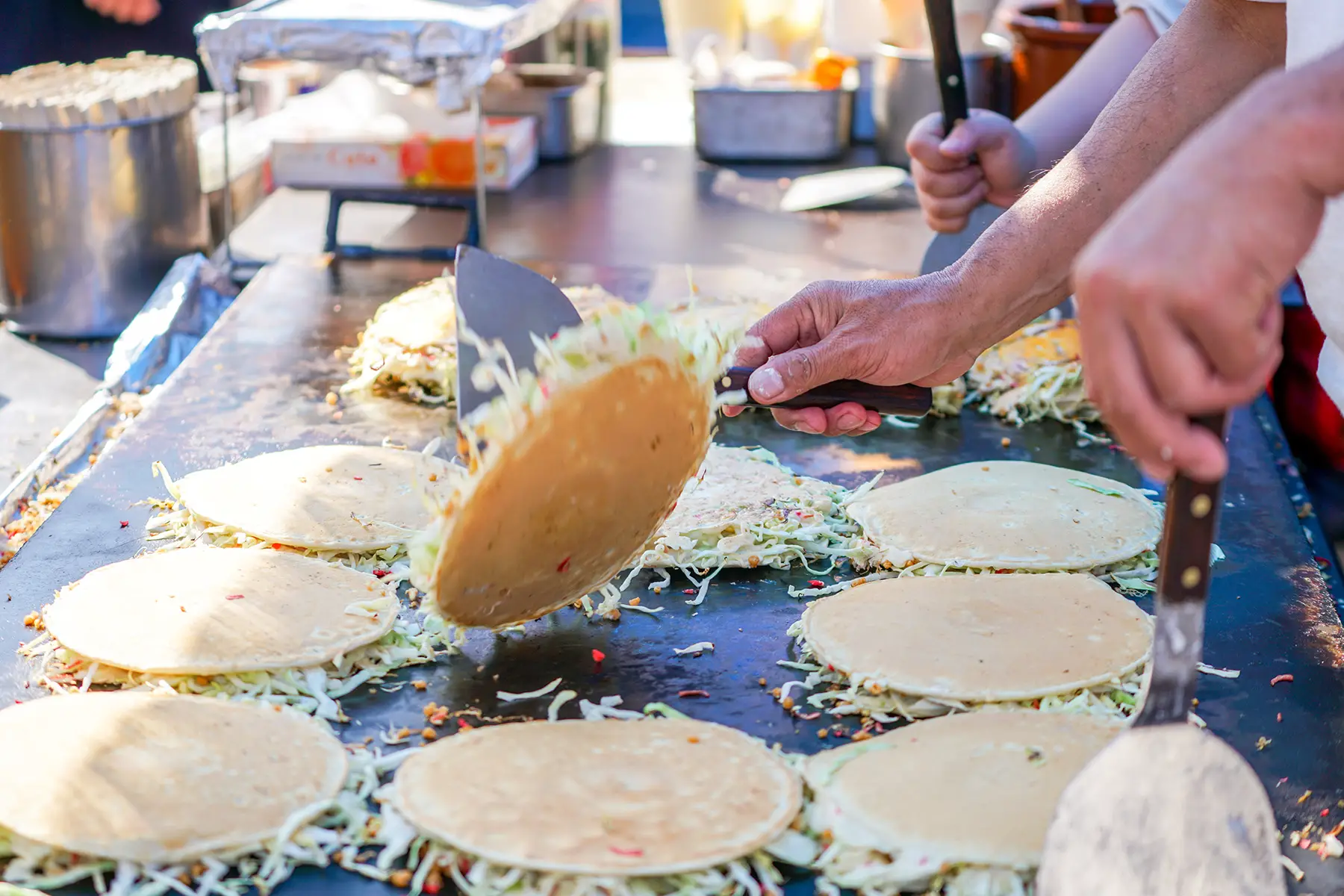
However, there is more to the story than just the use of meat. Each of Japan’s eight regions has developed its own unique culinary style and specialties, making traveling around Japan a thrill for food lovers.
Here is just a small sample of dishes from different parts of Japan:
- Ika Soumen (いかそうめん): Squid noodles dish from Hokkaido
- Okonomiyaki (お好み焼き) – grilled pancake-based dish popular as street food in Osaka, with another distinct version available in Hiroshima
- Chanko Nabe – hotpot recipe served in Kanto
- Tako Raisu – Mexican-inspired taco beef and rice dish unique to Okinawa
Useful resources
- Japan Centre – information on Japanese food, culture, ingredients, and recipes
- Tsunagu Japan – English-language website about Japan with a section on food and drink
